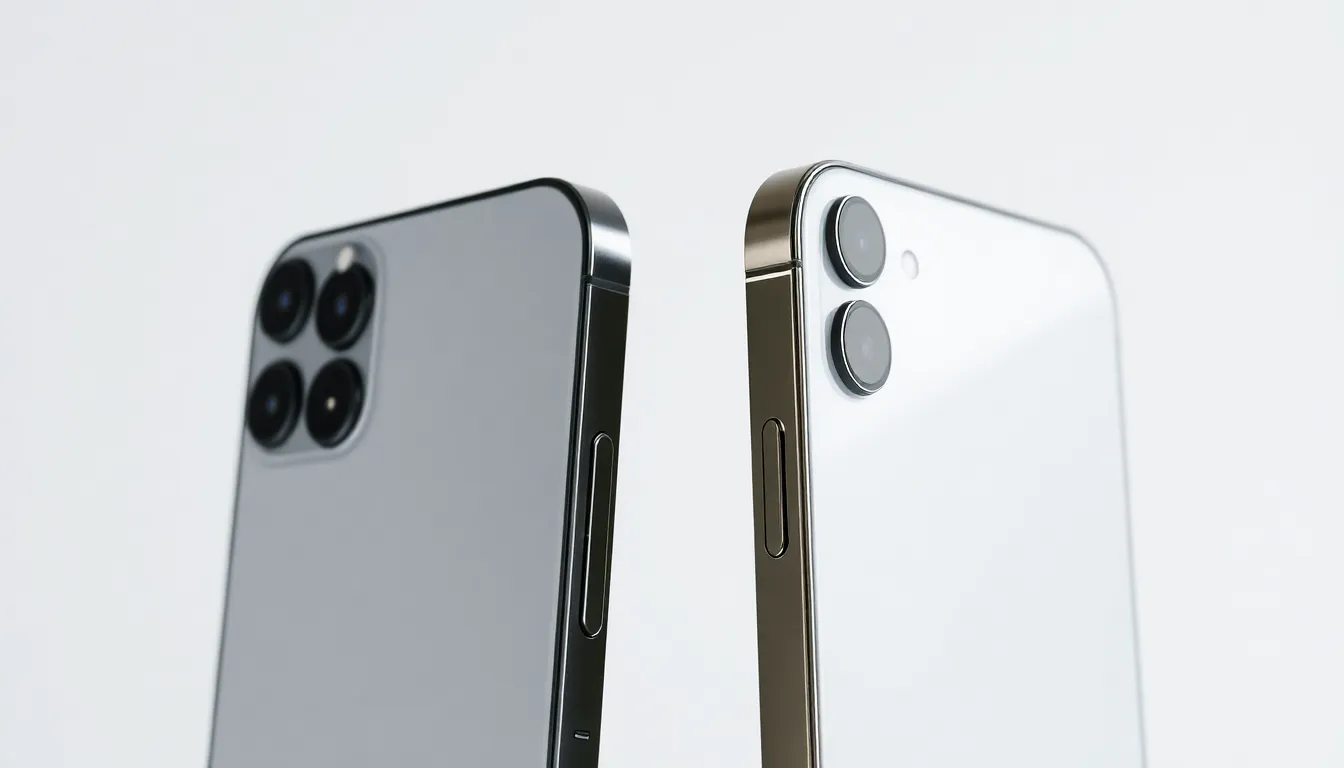When it comes to smartphones, Apple knows how to keep fans on their toes. The iPhone 11 and 12 may look like siblings at a family reunion, but dig a little deeper and you’ll find some juicy differences. If you’re torn between upgrading or sticking with your trusty 11, this guide will help you navigate the techy waters without getting lost in jargon.
From sleek designs to camera upgrades, each model has its quirks. The iPhone 12 is like that friend who shows up to the party with a new haircut and a killer playlist. Meanwhile, the iPhone 11 is the reliable buddy who’s always down for a good time. So let’s dive in and uncover what sets these two apart, ensuring you make the best choice for your pocket and your lifestyle.
Table of Contents
ToggleOverview of the iPhone 11 and 12
The iPhone 11 and iPhone 12 differ in design and performance. iPhone 11 features a glass back and aluminum frame, weighing 194 grams. iPhone 12 introduces an updated design with a ceramic shield front, making it more robust. Its weight is slightly less at 164 grams.
Display technology shows notable advancements. iPhone 11 has a 6.1-inch LCD display with a resolution of 1792 x 828 pixels. In contrast, iPhone 12 upgrades to a Super Retina XDR display measuring 6.1 inches, boasting a resolution of 2532 x 1170 pixels. This enhancement results in higher contrast and improved color accuracy.
Performance sees a significant boost in iPhone 12. It runs on the A14 Bionic chip, showing faster processing speeds than the A13 Bionic found in the iPhone 11. The newer model allows smoother multitasking and better graphics performance.
Camera systems appear similar, but iPhone 12 offers improved low-light capabilities. Both devices have a dual-camera setup with 12-megapixel wide and ultra-wide lenses. Night mode and Deep Fusion enhance iPhone 12’s photography experience, providing clearer shots in challenging lighting.
Battery life stands as another consideration. iPhone 11 features a battery life of up to 17 hours of talk time. iPhone 12 reduces this slightly to 15 hours but compensates with faster charging and MagSafe compatibility.
Connectivity also differs. Both support 4G LTE, but iPhone 12 adds 5G capability for faster download speeds in supported areas. With these distinctions, users can evaluate which model aligns better with their preferences and needs.
Design and Build Quality

The iPhone 11 and iPhone 12 showcase distinct design philosophies and build quality improvements. Subtle differences exist in their overall aesthetics and feel.
Size and Dimensions
The iPhone 11 measures 150.9 x 75.7 x 8.3 mm, while the iPhone 12 reduces its thickness to 7.4 mm and dimensions to 146.7 x 71.5 mm. With a lighter weight of 164 grams, the iPhone 12 enhances portability. These changes make the iPhone 12 easier to handle and fit comfortably in pockets. Users appreciate the streamlined profile of the iPhone 12, resulting in a sleeker appearance. Comparison reveals the iPhone 11 appears bulkier, especially with its rounded edges, while the iPhone 12 features flat edges for a modern look.
Materials Used
Materials significantly contribute to the build quality of both devices. The iPhone 11 utilizes an aluminum frame and glass back, ensuring durability. In contrast, the iPhone 12 introduces a ceramic shield front, providing better drop protection. Enhanced strength is evident in the iPhone 12, which incorporates aerospace-grade aluminum. Users benefit from increased resilience against scratches and everyday wear. The choice of materials in both models affects their finish, with the iPhone 12 offering a more premium feel. Consequently, aesthetics and durability complement each other, enhancing the overall user experience.
Display Features
The iPhone 11 and iPhone 12 exhibit notable differences in display capabilities. Each model’s screen technology plays a key role in user experience.
Screen Technology
The iPhone 11 utilizes a Liquid Retina LCD display that measures 6.1 inches. In contrast, the iPhone 12 features a 6.1-inch Super Retina XDR OLED display. This advancement offers deeper blacks and vibrant colors compared to the iPhone 11’s LCD. Enhanced contrast ratios in the iPhone 12’s display contribute to a more immersive viewing experience. Users notice sharper details, especially in high-definition content, thanks to this upgraded technology.
Brightness and Color Accuracy
Brightness levels in both models differ significantly, with the iPhone 12 achieving peak brightness of 1200 nits for HDR content. Meanwhile, the iPhone 11 peaks at 625 nits, which limits its performance in bright environments. Color accuracy also sees improvement in the iPhone 12, making images appear more true to life. Advanced features like HDR support elevate the visual experience on the iPhone 12. Users appreciate the enhanced vibrancy and clarity, especially while streaming videos or viewing photos.
Performance Comparisons
Performance marks a key difference between the iPhone 11 and iPhone 12. The iPhone 12 excels thanks to the A14 Bionic chip, featuring a 6-core CPU and a 4-core GPU. This architecture enhances speed and efficiency, resulting in smoother multitasking and improved gaming performance. Comparatively, the iPhone 11 utilizes the A13 Bionic chip, which, while powerful, doesn’t match the speed of its successor. Significant advancements in machine learning capabilities also exist with the A14, allowing for better image processing and app performance.
Processor Specifications
Processor specifications contribute significantly to device performance. The A14 Bionic chip employs a 5-nanometer process technology, enhancing speed while maintaining battery efficiency. This results in approximately 15% faster CPU speeds compared to the A13 Bionic of the iPhone 11. Similarly, the iPhone 12’s improved Neural Engine processes tasks up to 80% faster, allowing for richer experiences in applications and augmented reality. Users looking for high-performance smartphones will notice these differences in real-world usage.
Battery Life
Battery life features prominently in the comparison of these two devices. The iPhone 11 supports around 17 hours of talk time, proving reliable for daily use. Conversely, the iPhone 12 offers up to 15 hours of talk time, slightly less than its predecessor, yet provides faster charging options. Both models support wireless charging, but the iPhone 12 includes MagSafe compatibility, ensuring a more convenient experience. Users focusing on faster, more versatile charging practices typically benefit from the enhancements in the iPhone 12.
Camera Capabilities
The camera capabilities of the iPhone 11 and iPhone 12 showcase notable advancements. Users can appreciate the differences in hardware and photography features between the two models.
Camera Hardware
The iPhone 11 includes a dual-camera system with a 12MP wide and a 12MP ultra-wide lens. This arrangement allows for versatile photography but lacks advanced features. In comparison, the iPhone 12 also sports a dual-camera system featuring a 12MP wide and a 12MP ultra-wide lens. Enhanced low-light performance stems from the iPhone 12’s wider aperture of f/1.6 on the wide lens, improving light intake for brighter photos. Night mode is available on both models, yet the iPhone 12 optimizes it for better clarity in low-light situations.
Photography Features
Photography features differ significantly between the two models. The iPhone 11 supports standard HDR for improved highlights and shadows. Comparatively, the iPhone 12 features Smart HDR 3, enhancing photo quality through better scene recognition. This technology captures more detail and color accuracy in complex scenes. Additionally, the iPhone 12 supports Night mode across both the main and ultra-wide lenses, allowing night-time photography flexibility. Portrait mode remains a strong point in both devices, but the iPhone 12’s enhancements elevate subject separation, resulting in striking images.
Software and Features
Both the iPhone 11 and iPhone 12 come equipped with advanced software and features that enhance user experience.
iOS Improvements
iPhone 12 runs on a more advanced iOS version than iPhone 11, offering several new features. Smart Data Mode helps save battery life by automatically switching between 5G and 4G, based on user activities. Enhanced privacy measures ensure data security, with features like App Tracking Transparency giving users control over their data. Widgets have become more interactive, providing real-time information on the home screen. Users on the iPhone 12 access optimizations in Siri and grouped notifications. A seamless experience with the latest iOS updates keeps both devices relevant, although the iPhone 12 has the edge in performance and features.
Unique Features of iPhone 12
Unique to iPhone 12, MagSafe technology allows accessories to easily attach using magnets. This innovative feature includes a range of accessories, such as cases and wireless chargers. Support for 5G connectivity offers faster speeds, enhancing browsing, gaming, and streaming activities. Night mode is available across both cameras, improving low-light photography dramatically. The inclusion of Smart HDR 3 provides better scene analysis and photo quality. Users benefit from a Ceramic Shield front, boosting durability by 4 times compared to prior models. This combination of features enhances both functionality and user satisfaction significantly.
Pricing and Availability
iPhone 11 pricing starts at approximately $499 for the base model with 64GB of storage. Availability remains consistent, as both new and refurbished units can often be found at various retailers. Discounts are common, especially during promotional events.
iPhone 12 pricing begins at around $699 for the 64GB model. It’s available through major carriers and on Apple’s website, ensuring a wide range of purchasing options. Seasonal promotions and trade-in offers enhance purchase affordability.
Overall, iPhone 11 offers a more budget-friendly option for those seeking reliability without the latest features. iPhone 12 presents a modern upgrade, reflecting advancements in technology at a higher price point.
Comparison highlights that while both devices remain widely available, the iPhone 12’s newer features justify its premium pricing. Selecting the right model often depends on personal preferences and budget constraints. Consumers should consider warranties and installment plans available for each device, as these can provide additional financial flexibility.
Choosing between the iPhone 11 and iPhone 12 ultimately comes down to individual needs and preferences. The iPhone 11 offers solid performance and reliability at a more accessible price point. It’s a great choice for those who want a dependable device without breaking the bank.
On the other hand, the iPhone 12 stands out with its advanced features and sleek design. With improvements in display technology, performance, and camera capabilities, it appeals to users looking for the latest innovations.
Whether prioritizing budget or cutting-edge technology, both models provide excellent options that cater to different lifestyles.









